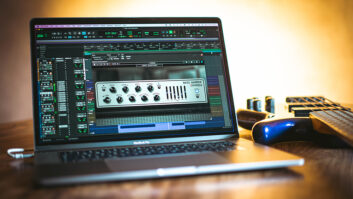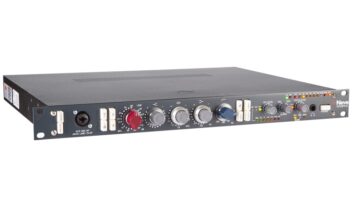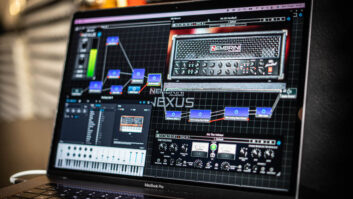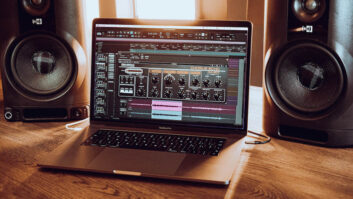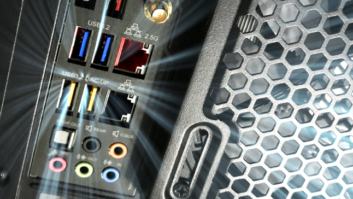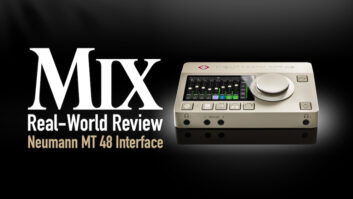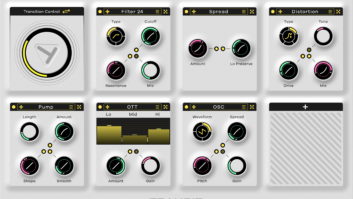Most engineers feel they have to make a choice: Mac or PC? More and more, the savvy engineer is fluent in both and can make the two talk.
As I got deeper, I realized that the fundamental issue in building a multiplatform studio is becoming aware that it’s necessary to restructure the way the craft of mixing is addressed.
Technology options for the project studio owner have multiplied in the past several years. Control surfaces from Digidesign, Mackie and others can be used as powerful front ends to any number of hard disk recording platforms, and, in most cases, these control surfaces have made mixing on the computer much easier. But working this way requires a careful planning of horsepower requirements and a reassessment of the visual aspect of mixing. Can you live with a single computer monitor, or even two?
Regardless, most engineers feel that they have to make a choice: Mac or PC? But as platforms have become more stable and manufacturers purposely engineer for both, the question has really become one of personal preference. More and more, the savvy engineer is fluent in both and can make the two talk.
If you take this approach, as I have, then the question of how best to lock multiple computers together comes into play. The potential for problems increases exponentially as more devices are added. To a studio that already included a Macintosh computer running a card-based recording system and a digital console, I added a PC as a station for a software-based sampler and some soft synths. How difficult was it to integrate this computer and the add-on hardware it required? And what is the most rational formula to use when comparing the cost of soft synths (and the hardware they require) and the equipment they are meant to replace? Let’s break the process down into distinct stages.
Prior to the acquisition of a PC, my studio consisted of a Power Tower Pro Mac clone running a NewerTechnology 500MHz G3 upgrade. Digital recording is executed using a 32-track E-mu PARIS hard disk recording system. I achieve lockup between the board, PARIS and the Mac by running a SMPTE stripe from an edge track of PARIS into my MOTU MIDI Time Piece A/V. The MTP splits the signal and sends it to my Mackie D8B (which I’ve set up as a MIDI device) and back to the computer itself. Eight channels of digital information can be exchanged at one time between PARIS and the D8B via a Lightpipe connection. A BNC connection between the two ensures proper sync.
For my new PC, I purchased a Waverunner computer from the Eastcoast Music Mall, a Connecticut store that attracted my attention because of the heavy emphasis it gives to training seminars. This 900MHz Pentium PC is designed by Pete Leoni for Q Performance, a division of the Eastcoast Music Mall. The computer came loaded with Nemesys GigaStudio 160, Cubase VST/32 and several soft synths, including the Native Instruments B4 organ, Pro-52 (a software emulation of the Prophet 5) and the Waldorf PPG.
The basic concept is quite simple. The Waverunner computer serves as a station that includes both GigaStudio and Cubase, which serves as a shell for the VST instruments. Pivotal to understanding how this game works is the realization that GigaStudio (GigaSampler on steroids, with mixing capability and effects augmenting the sampler functions) and VST instruments, loaded into the PC, are seen by MOTU’s Digital Performer (which is loaded into my Mac and used as a MIDI sequencer only) as independent MIDI devices. Morgan Pettinato, owner of the Eastcoast Music Mall, and Pete Leoni suggested that I incorporate a Frontier Design Group Dakota digital I/O card and a daughter card from the same manufacturer, the Montana card.
Setting the computer up and integrating it into my studio was surprisingly easy. Once GigaStudio and Cubase were confirmed as operational, I opened up my basic Digital Performer template and added both GigaStudio and Native Instruments as FreeMidi devices. MIDI connections were made between the Dakota card and my MIDI Time Piece for GigaStudio, and the Montana card and MTP for Native Instruments. Leoni says that all computer devices used to shuttle digital audio should be wordclocked from a single master, so I routed a BNC cable from the Lightpipe card in my D8B, which is used to accept the first eight channels of the Dakota card. Because the Montana is a daughter card that extends the functionality of the Dakota, giving me another eight channels of Lightpipe, which I use for GigaStudio, it need not be given separate wordclock connections.
Having to purchase a sequencer to act as a shell for VST instruments seemed redundant at first (you don’t have to purchase the full-blown version of Cubase to get this functionality, by the way), but as I got deeper, I realized that the fundamental issue in building a multiplatform studio is being aware that it’s necessary to restructure the way the craft of mixing is addressed. No longer a line that leads multiple devices to a single destination, the board, where they are mixed and bused out, the new modality requires a rethinking of the process and treating sounds at different points of the system. If this is done intelligently, then the result will be a maximum use of horsepower (for tracks and effects), physical inputs and outputs, and outboard gear. Having the flexibility to mix all of the VST instruments within Cubase, at least for monitoring purposes while working a piece, is, I came to realize, a distinct plus.
Becoming comfortable with the PC came next. Not having owned a PC for over 10 years, I was initially reticent about diving back in. Things have changed, though, and Windows 98 presented me with no great difficulties, though I still saddle up to the Mac with greater authority.
I had been using an Akai S2000 as my main sampler, along with a pair of Sample Cell cards. What a switch! Using a 2x CD-ROM unit with the S2000 was tediously slow, whereas loading 16 banks of sounds into GigaStudio on the Waverunner takes only a snap of the fingers. I did notice that the Nemesys conversion utility was questionable at best (Nemesys knows it has limitations and is working to improve the utility, offering it as a courtesy feature at this time) and looked for options. There are several utilities that can help here. I settled on CDxtract, which can be purchased for $44 as a download only (www.cdxtract.com). I’ve had 100% success converting my entire Akai library to disk using this utility. By the way, I ordered my Waverunner with 40 gigs of space on the disk used to store audio. Get as much memory and disk space as you can!
Reviews of the Native Instruments soft synths are easily found these days. Let me simply say that the B4 blew me away. Simulated Hammonds live or die by the way they re-create Leslie effects, and you’ve got to hear the way Native Instruments handles this task. You’ll save your back and your pocketbook’s health by checking out the NI version. Same goes for the Pro-52.
Up to this point, things had been cool. My entire library was on hard drive. Mixing and adding effects within Cubase and GigaStudio, and porting out individual tracks of each to the D8B via Lightpipe, had been achieved with minimum bloodshed. Ditto all clocking and MIDI issues. But…
During my initial setup, I spoke to tech support at both Nemesys and Steinberg. I kept hearing that a computer like the Waverunner, if properly set up, would be able to run both applications simultaneously without any problems. Wrong! At this time, I have concluded that it is impossible to run GigaStudio and VST instruments on a single computer — even if you’re already using a separate computer to house MIDI and digital audio recording hardware and software. A drag, I agree. However, GigaStudio, in particular, pulls too hard on the system to allow for VST instruments to run properly. I reduced things all the way down, dividing a two-line musical performance between single MIDI channels on both applications. The result? Digital clicks and pops. We even tried swapping out the Montana card with a Hammerfall I/O card, an excellent performer.
Therefore, when it comes time to budget your new system, if you’ve fallen in love with the GigaStudio/soft synth paradigm, then you may want to think about buying a pair of new computers. Strange, isn’t it? No one thinks twice about spending a couple grand on a synth module or sample playback device that comes as a discrete hardware device. But we resist buying computers, no matter how low the cost, to execute individual or limited tasks.
The good news, with respect to the let’s-keep-both-platforms-in-one-computer model, is that there’s a workaround that will help you out, provided you can live with the annoyance of intermittent digital hash while laying down MIDI performances. The key here is to understand that limiting latency — the time it takes a MIDI command to pass through a computer like the Waverunner — draws heavily on the host processor. If you want to hear those mondo cool drum parts you laid down in GigaStudio using Bashiri Johnson’s new Ethno Techno collection, for example, while MIDI tracking your Gregg Allman-like B4 performance, then you have to limit your latency to 12 ms or so. The result? Correctomundo: pops and clicks. Bumping up the latency to a degree that eliminates the digital noise results in a delay between the time a note is struck and when it is heard that makes tracking impossible.
Playback is altogether another matter. In playback, the Waverunner is not required to simultaneously receive a MIDI performance and send it out to a VST instrument, so it can buffer the audio. Increase the latency setting in your audio card’s control panel and away go the troubles down the drain. Use low-latency settings when recording MIDI data, live with the clicks and pops and bump up the latency for clean playback — that’s the formula. If you can live with it, then both programs can be used on a single computer. Be aware that there are still a finite number of voices that the computer can play at one time. I have found that three or four VST instruments and a handful of GigaStudio instruments, with no effects processing (in this scenario, I leave that to my D8B) can play at one time. If I need to add more parts, I begin to drop tracks, via Lightpipe, into PARIS.
Calculating the relative costs of the various technical scenarios can be confusing. Why? Because direct one-for-one feature set comparisons are never possible. The computer-plus-applications paradigm generally offers a lot more than the stand-alone devices they’re meant to replace, although there are exceptions to this rule; for example, the editing capabilities of an E4 are far more powerful than those found in GigaStudio. If you want to edit your sounds, and who doesn’t, then you’re going to have to cough up some extra dough for a program like Steinberg’s Wave Lab.
But think of the advantages of using a 19-inch monitor to view all of the GigaStudio mix parameters. How much value do you place on that ease-of-use factor? And we’re not even talking about the power of the GigaSampler engine itself, or the quality of the EQ (quite acceptable in my book) and effects (serviceable reverbs).
The bottom line is that the Waverunner p900 I bought costs $995. It includes a 50x CD-ROM drive. Throw in another couple hundred bucks for the rackmounting, add on a monitor and you’re still way under $2,000. But we’re not done yet.
You’ll need I/O. I was really impressed with both the Frontier Designs and Hammerfall cards I tested. Let’s figure you spend another $550 getting 32 channels of Lightpipe from Frontier Designs, and several hundred dollars more if you choose to go with the Hammerfall 9652. Adding Cubase VST 5.0 software to act as a shell for your VST instruments adds another $295. If you can live with 16-bit resolution, a cheaper option is Steinberg’s Cubasis. And for $75, you’ll get a stripped-down version of Cubase that will work as a shell for your VST instruments. Then there’s the roughly $200 you’ll cough up for the B4, Pro-52 and maybe another pair of soft synths. And you’ll drop about $550 on GigaStudio 160.
Run the numbers, and you’ll find that it costs about $4,000 to get all this stuff into your studio. You could reduce the figure a bit by scouring around for the fastest components and troubleshooting them within one computer to make sure nothing conflicts, like Pete Leoni of Q Performance does, but why? They’ll take the heat if things don’t work.
The four beans you’re about to let go of buys an extraordinary amount of power, measured in available voices and mixing capabilities, and you’ll be working in a 24-bit world. (Provided you haven’t skimped out and gone for Cubasis.) Most likely, you’ll be able to sell some old synth hardware and recoup a portion of your investment to boot. However, many people seem reticent to give up hardware, and part of the reason, I’m convinced, is the comfort that derives from looking at a piece of gear and knowing instantly what it does. Software doesn’t offer the same tactile and visual experience, so things can get confusing, particularly when you’re trying to allocate outputs. Remember, in the model we’ve constructed, you’ve essentially bought more voices than I/O. A new thought process is required. Are the EQ and effects in Cubase good enough to use to create a two-mix on the seven tracks of drums you created with the LM4 soft synth kit? If not, can you live with a two-mix, plus one or two tracks independently bused out to your console for processing?
Tackling these kinds of questions represents the greatest challenge, I believe, to the player/engineer who is considering creating a multiple-station mix environment.
Gary Eskow is a composer and producer who lives in central New Jersey. His recently recorded chamber music CD, Many Streams, One River, will be released this year. Eskow is currently producing an album of smooth jazz, Before the Memory Fades, for the saxophonist Barry Raymonde.

